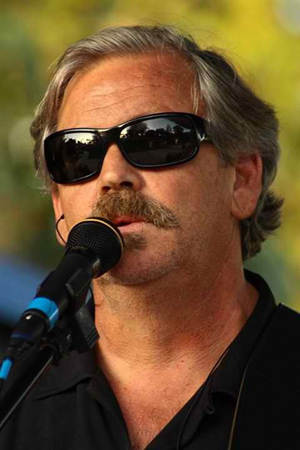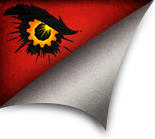
This month's Get to Know a Dev is all about Senior Artist Kevin Lydy!

Playing an outdoor festival this summer. It's a darned good thing I have a day job!
I've had the good fortune of being in the industry for 26 years now. I got my start making arcade games in the 80s after eavesdropping on a conversation at Happy Hour one evening. I've been involved with more than 50 releases at Cinematronics, Leland/Tradewest, Midway, SCEA and Sony Online Entertainment, among others. I have served as Artist, Animator, Art Director, Vice President, and just about everything else, including Janitor at times. Even after all these years, I still can't wait to get to the office in the morning. Every day is every bit as exciting as the very first one.
One side note… After leaving Midway to "get my hands back in the clay", I was doing freelance/contract work. One of the projects I landed was doing a logo and some FMV stuff for a new game. That new game turned out to be EverQuest.
My educational background is somewhat diverse. I have degrees in Commercial Art, Computer Science, and I'm half a dozen credits shy of a Fine Art degree. I continue to be a humble student of them all.
Here at SOE, I've done primarily environments the past few years. Occasionally, I do some character/animation work, 2D stuff and effects as well. But most of my responsibilities are focused on creating 3D environments and their respective components.
Typically, when approaching a new environment, I have a somewhat standard process. We're fortunate to have really good designers on EverQuest. They routinely develop interesting story lines and lore that make my job really fun. There's always a ton of great ideas to work off of.
I try to approach each new environment a little bit like a Production Designer for a film project might – asking questions. What is this place? Who inhabits it? Who has been there in the past? What goes on there? What part does it play in the storyline? That sort of thing.
The first thing I do is a bunch of research. I look around for real world, historical, mythical places that have similarities with the environment to be created and the story line. For example, before I started working on the temples in West and East Sepulcher, temples to the gods, I studied the Pantheon in Rome, also a temple to the gods, for inspiration. The Pantheon has this quiet majesty and reverence about it that I hoped to bring to our temples. I did some drawings of the architectural shapes, details and overall spatial relationships. Much of what wound up in those areas was directly inspired by the Pantheon, although it's not a literal translation by any means. Everything has a unique quality that, hopefully, delivers an appropriate sense of place and evokes a similar response as the Pantheon.
Next, we do simple, 3D layouts of the environments that we call stubs. Stubs are a quick and easy way to visualize the space in 3D that you can actually run around in. Stubs are repeatedly revised prior to actual production to accommodate play value mechanisms, raids, performance issues and overall aesthetics.
When I start to actually build the space, I try to come up with a signature element. By that, I mean an element or component that serves as a centerpiece in the area(s) that will set the tone. For example, in the valley section of Arelis that has been rife with conflict, the burnt, smoking tree sets the tone. Right away, you get a sense that it ain't no vacation spot. It supports the storyline and the purpose of the surrounding terrain.
And then, we're off to the races. Using the stub as a guide, and often building right into it, the zone starts to take shape. This is a really rewarding phase as the environment begins to come to life. It's not unusual, during this phase, for me to forget to have lunch, (although you wouldn't know it by my waist line), look up to see that I'm really late for an evening appointment, or sneak in on the weekends.
The next two, three, sometimes four, months things take shape. It's a cycle of build some, test some, build some, and test some. The whole time I'm building things out, I'm constantly being sensitive to performance issues, play value concerns, and the clock. No one wants to play a sluggish, uncomfortable, not fun game that they have to wait two years to get. These issues and concerns play a big part in the process of what gets delivered. As a rule, they are in constant competition with look-and-feel aesthetics and we're always juggling both.
The last stage is lighting and effects. The lighting really makes things sing. It really finishes off the tone or mood an environment. To get things just right requires a fair amount of patience and repeated trial and error. It's an offline process. So feedback isn't instantaneous -- hence, the need for patience. A high tolerance for repetition is also useful.
The effects part is an area that I'm especially sensitive to. One of my goals is to try and deliver an environment with "air." By air, I mean a combination of lighting and effects that provides a sense of "life" - a sense that this is a living, breathing real world place that actually exists. Or, in other words, a place and experience that suspends disbelief. With playability and performance in mind, this is always a challenge. But when it happens, it's the sweet icing on the cake.
One thing everyone should know… The EQ team is filled with dedicated, inspiring, hard working, totally committed people. We don't just work on the game, we live it - 24/7. It is treated much like a parent would a child. It is fostered with limitless respect and care. And, as a parent would do, sacrifices are frequently necessary. I know I speak for us all when I say that we hope to continue doing so for a very long time
Rest assured, the desires and wishes of the EQ community are always foremost in our minds. I know that, even when I'm not working, EQ is bouncing around in my noodle. When I come in on the weekends, there are almost as many cars in the parking lot as there are on a weekday. So the next time you log on, know that a bunch of people are sweating blood into the game with one single goal – your enjoyment. Nothing makes us happier, or more grateful, than you folks enjoying EverQuest.
The same can be said of SOE, in general. From person to person, team to team, building to building, everyone involved has a deep commitment to producing the finest games possible. We all live and love our work. With the inspiring people, tremendous environment, and top-notch games at SOE, it is without a doubt the finest experience of my career. And I'm ever so grateful for the opportunity to be a part of it.
Personal stuff… I live at the beach about 30 minutes north of the SOE campus with my lovely wife Dorothy, my Cocker Spaniel named Woody (whose favorite color is food), and Jerry the Cockatiel. Jerry is very entertaining. He talks up a storm and whistles cat calls whenever women walk into the room. I'm trying to teach him some manners, but I've been unsuccessful thus far.
I'm also involved in making music. I have been a part-time, working musician for 35 years. (Yeah, you'd think I'd be better at it by now.) It's one of my great loves. I played *almost* full time for a couple of years in the early 80s. But the brass ring proved elusive. Or, as they say, many are called -- few are chosen. As good fortune would have it, I wound up being introduced to my other great, life long passion – making games.
Thank you for your time and I sincerely hope you'll continue enjoying your EverQuest experience.
So now that you know a bit more about him, let's get started with the questions! Please post your questions for Senior Artist Kevin Lydy to the appropriate thread on the forums. Submissions will be open until 11:59 p.m. Pacific on October 23, 2011, at which point we will select the best questions and have Senior Artist Kevin Lydy answer them! The results will be posted on the forum and website.
Let the questioning begin!

